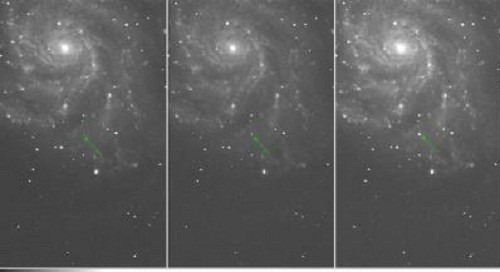Scientists Find Brightest Supernova in 40 Years in Pinwheel Galaxy

Astronomers have spotted the brightest supernova in 40 years in the Pinwheel Galaxy, which lies only about 21 million light years away from Earth and located in the famous constellation of the Great Bear (Ursa Major).
The latest supernova is being dubbed PTF11kly and classified as type 1a supernova.
Supernova is nothing but exploding stars and play an important role in the evolution of galaxies and planetary systems as they are the source of most of the chemical elements in the universe heavier than iron. They also seed the rest of space with elements such as carbon, oxygen and nitrogen, and can nudge gas clouds into collapsing to form new star systems.
The discovery of such a supernova so early and so close to Earth has energized the astronomical community, which believes they caught the supernova within hours of its explosion, a rare feat made possible with a specialized survey telescope and state-of-the-art computational tools.
Scientists from the University of Oxford made the discovery on Aug. 24 along with their colleagues from the Palomar Transient Factory (PTF), using a robotic telescope in California.
The scientists in PTF have discovered more than 1,000 supernovae since it started operating in 2008, but they believe this could be their most significant discovery yet. The last time a supernova of this sort occurred so close was in 1972. They are calling the latest exploding star as supernova of a generation.
The most exciting thing is that this is what's known as a type 1a supernova - the kind we use to measure the expansion of the Universe. Seeing one explode so close by allows us to study these events in unprecedented detail, said Oxford team leader Mark Sullivan.
Meanwhile, the astronomers say that the supernova is still getting brighter, and it could be visible with good binoculars in ten days' time.
We caught this supernova very soon after explosion. PTF 11kly is getting brighter by the minute. It's already 20 times brighter than it was yesterday, said Peter Nugent, a senior scientist at Berkeley Lab who first spotted the supernova.
The best time to see this exploding star will be just after evening twilight in the Northern hemisphere in a week or so's time. You'll need dark skies and a good pair of binoculars, although a small telescope would be even better, Sullivan said.
The team will be watching carefully over the next few weeks, and hope to use NASA's Hubble Space Telescope to study the supernova's chemistry and physics.
Observing PTF 11kly unfold should be a wild ride. It is an instant cosmic classic, Nugent said.
The Palomar Transient Factory is a wide-field survey operated at the Palomar Observatory by the California Institute of Technology on behalf of a worldwide consortium of partner institutions. The project is supported by DOE's Scientific Discovery through Advanced Computing (SciDAC) program and by NASA.
© Copyright IBTimes 2024. All rights reserved.




















